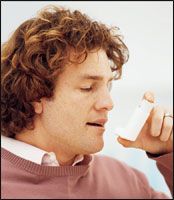Publication
Article
Pharmacy Times
Inhalers: Out with the Old, In with the New
Author(s):
With the phase out of CFC-containing metered dose inhalers, pharmacists are in a pivotal position to educate patients on how to use the new devices.
Dr. Brown is an assistant professor ofpharmacy practice at Palm BeachAtlantic University, Lloyd L. GregorySchool of Pharmacy, Palm Beach,Florida.
Billy is a regular customer in your pharmacywho comes in with a new prescriptionfor albuterol. As he hands you theprescription, he states, "Don't give methat ?new inhaler' that you did last time.That thing doesn't work! I want the onethat I used to get." As you glance at hisprofile, you notice that Proventil HFA wasdispensed approximately 1 month ago,and this was the first time that he hasreceived 1 of the newly formulated MDIs.How would you respond?

Metered dose inhalers (MDIs)were first introduced into themarket in the 1950s by RikerLaboratories when the daughter of thecompany president asked her father whyher medication for asthma could not begiven in spray formulation like hairspray.This idea eventually led to the developmentof MDIs, among the most commonlyused devices in the world for respiratorydiseases such as asthma and chronicobstructive pulmonary disease.1,2
Though these devices are widely used,they are heavily dependent on patienttechnique and the ability to properlyactuate the device. Most of the medicationdelivered via the MDI does not reachits intended destination. In fact, 10% to25% of the medication actually makes itto the lungs, with the majority of itdepositing in the oropharynx, and someof the medication being retained in themouthpiece of the device.1,2
The Problem
In 1974, it was first theorized that thepropellant contained in all MDIs, chlorofluorocarbon(CFC), was linked to ozonelayer depletion. The argument of howMDIs damage the ozone layer has beenraised as patients are inhaling the product,not spraying it into the atmosphere.Emission of CFCs into the air occurs aspatients exhale as part of MDI delivery.
Until 1995, all MDIs contained CFCs.1 Inan effort to minimize damage to theozone layer, the Montreal Protocol calledfor the phasing out of CFC-containingproducts; in response, pharmaceuticalcompanies established the InternationalPharmaceutical Aerosol Consortium toresearch and develop formulations thatwould serve as suitable alternatives toCFC-containing MDIs.1,4
One potential solution was to allow drypowder inhalers (DPIs) to replace MDIs.Though frequently used today in thedelivery of inhaled glucocorticoids andlong-acting beta2 agonists, DPIs can beexpensive to manufacture, are adverselyaffected by humidity, and require fastinhalation, which potentially could beproblematic in patients with severelydiminished lung function.2 Thus, attentionturned to the hydrofluoroalkanes (HFAs),particularly HFA-134a (also known astetrafluoroethane) and HFA-227 (alsoknown as heptafluoropropane), as a newpropellant for MDIs. HFAs have not beenlinked to depletion of the ozone layer andare nonflammable. It should be noted,however, that these agents still contributeto the greenhouse effect, but to alesser extent compared with CFCs.1
Adjusting to a New Product
The FDA has required that all MDIscontaining CFCs cannot be marketedafter December 31, 2008.5 Pharmacieshave begun the transition to the newHFA-containing MDIs, and many patientsare being switched over to the new products.Additionally, the FDA has proposeda new rule to remove the "essential use"designation from epinephrine-containingMDIs currently available over the counter.Under this rule, epinephrine productscontaining CFCs would be phased out by2010. If a non-CFC product containingepinephrine is not available by this time,a prescription for analternative would berequired.6
With the developmentof HFA-containingMDIs, manufacturershad to ensurethey wereequivalent to CFC-containingMDIs. Thisprompted reevaluationof MDI performance,particularly assessmentof bothinter- and intra-patientdosing inconsistencies,the "cold" effect often described with inhalation involvingFreon, force of the spray, and effect of humidity. A widermouthpiece, smaller actuator orifice, spray temperature abovefreezing, and reduced jetting velocity (force of spray) all havecontributed to a difference in feel, sound, and shape of the newHFA-containing MDIs.2 As such, many patients like Billy maystate that they do not feel the newer devices are effective.Patient education can play a large role in helping patients understandthe differences in the newer devices.
Pharmacist?Patient Interaction
Many patients may question why they must be switched tothe newer HFA-containing MDIs. It is important to stress that thechange has resulted from environmental damage associatedwith the older CFC-containing MDIs, not damage to the physicalhealth of the patient. Stressing the importance of proper devicetechnique—along with demonstration—may alleviate patientconcern for those who cannot feel or taste the dose containedin HFA MDIs.
It is estimated that approximately two thirds of patient usersand health care providers involved in MDI technique training donot perform the process correctly.2 The Table contains theappropriate steps involved in MDI usage. In addition, cost is acommon concern among patients with the phase out of the oldinhalers. The new medications generally are reported to bemore expensive than the older generic products that were available;however, their use should continue to be encouraged as aquick relief medication, especially in emergencies. Use of theagents potentially can be minimized with appropriate controllermedications for respiratory conditions.
With the phase out of the CFC-containing MDIs, pharmacistsare in a pivotal position to educate patients on the importanceof appropriate device technique and how the newer HFA-containingdevices differ from older ones.
Steps Involved in the Appropriate Use of MDIs
- Remove cap and shake MDI well.
- Exhale completely.
- Either place mouthpiece in mouth with lips sealed tightly around (not recommended for steroid use) or hold device mouthpiece 1 to 2 inches from open mouth (about the width of 2 fingers). NOTE: a spacer or holding chamber also may be used in patients having difficulty with coordination of technique.
- While inhaling, actuate or press down on the inhaler to release the medication.
- Keep breathing in slowly and steadily.
- Hold breath for about 10 seconds to allow medication to settle in the lungs.
- Exhale slowly and wait about 1 minute between puffs if more than 1 is required. (This should occur with short-acting medications like albuterol.) It is not necessary to wait between inhalations of any other medications.
MDI = metered dose inhaler.
Adapted from reference 7.
References







